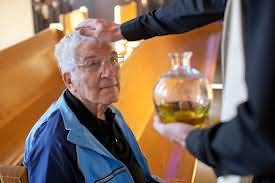Kathleen Chesto presents the least known and most neglected sacrament: The Anointing of the sick. It is in times of our greatest sufferings that mankind turns to God to ask for His healing graces. When we are ill with disease and pain we ask for others to pray for us. My parish has a prayer line, a parish book for prayer and prayer blankets. The prayer blankets are handmade and blessed by our priest and parish members. They are given to children and adults with illness and disease. We do this to cover those suffering with comfort and consolation of our praying as a community of believers.
So many times those who fall ill also fall outside of the perimeters of community. It is in this time that we need people the most. We pray for healing and God’s will to be done for those suffering. The healings by Jesus Christ were so significant to the the Gospel. Kathleen explains those healing miracles were not amazing simply because they were miracles but because they pointed to Jesus Christ as the Messiah. “Jesus Christ raised Lazarus from the dead pointing the Resurrection of dead to new life. He gave sight to the blind proclaiming He Himself was the light. He multiplied the loaves and the fish and promised himself as the living bread of life.”
Early on before the time of Christ people believed in a holistic view point. Primitive people used medicinal treatments to heal not only the physical ailments but the spiritual as well as healing the sins. The book of Job was to overcome the idea that misfortune and illness are a direct result of evil doings. Instead evil in the world was held accountable. The only thing that could heal all was the coming of the Messiah. Christ came and laid hands and healed. After the Resurrection and Ascension the apostles healed many.
The first healing ministry is found in the Epistle of James and in it sins and forgiveness are still linked to the illness. It directed elders of the Church to heal. Although at this time the lay people of the Church were administering anointing of the sick. In the 5th century Pope Innocent I insisted that lay people should help with this sacrament. Lay people asked freely for this sacrament until late into the 8th century when it got mixed up with Canonical Penance and the last rights. It looked so similar that people believed it was only for those near death and if you lived you would have an enormous penance to fulfill.
In the 9th century during the reign of Charlemagne this sacrament was changed by one of the emperor’s court scholars, he was not a part of the church. He wrote that the anointing must only be administered by a priest and abolished the anointing by lay people. The perception changed the sacrament to the last rights or extreme unction. In the 16th century the Council of Trent reinforced this idea. The sacrament was to be given by only the priest and only at the time of death.
The Council of Vatican II supported pastoral care; the priest should pray and counsel, read scripture, and reassure the sick person of the love and care of the community. Although the priest is the one that administers this sacrament many parishes have been called upon to have the lay people take part in pastoral care by visiting the sick and shut ins and encouraging them to support and love them through their difficult times.
Now the Catechism says, “The anointing of the sick is not a sacrament for those only who are at the point of death. Hence, as soon as anyone of the faithful begins to be in danger of death from sickness or old age, the fitting time for him to receive this sacrament has certainly already arrived” (CCC1514).
My favorite miracle from the gospels is “the woman with a hemorrhage”. This woman had been ill for twelve years and she spent all she had to be healed by doctors to no avail. She heard that Jesus was close by and found her way into the crowds. She thought to herself “If I but touch his clothes, I shall be healed.” Jesus, aware at once that power had gone out from him, turned around in the crowd and asked, “Who has touched my clothes?” The woman fell down before Jesus and told him the whole truth. He said to her, “Daughter, your faith has saved you. Go in peace and be cured of your afflicition.” – Mark 5:25-34
This is my favorite miracle because the woman had faith that Jesus could heal her. She knew that all she had to do was to touch Jesus and she would be healed. She believed so much that she was not going to ask for healing but just touch him. I believe it proved to the disciples that He was God when he asked “Who touched me?” Although the disciples were slow and did not realize it at the time. Jesus was kind and compassionate to the woman and told her that her faith had saved her. It is another time that faith heals wounds. I believe that if our faith is strong enough and God grants it miracles will occur.
The anointing of the sick is a sacrament that can be used for many healings in our world today. More people should ask for this sacrament to be at peace with their bodies and with God.




This sacrament is also given to those struggling with mental and emotional trauma in their lives and those with chronic ailments, not just life threatening or terminal illness. It can be powerful to those witnessing an anointing, as family and community gather and add their prayers to those celebrating the sacrament.